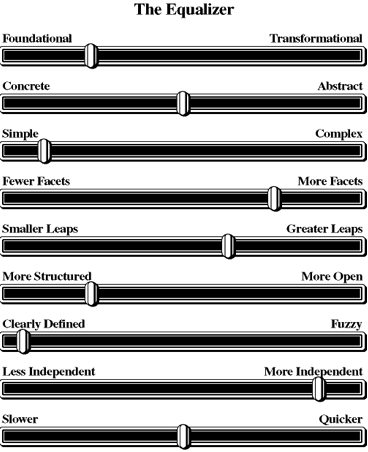
Week Four
Differentiated Instruction (DI) and Understanding by Design (UbD) - Theory Into
Action
Carol Ann Tomlinson developed
the continuum-style approach that she turned into a graphic model she calls
the equalizer. It is called the equalizer because its goal is to equalize the
opportunity for each learner to encounter an appropriate level of challenge
while learning about the same concept and essential understandings.
The equalizer identifies a variety of instructional elements that can be modified
to challenge students at different levels of readiness. The equalizer can be
used as a visual tool for understanding the concept of differentiation and for
learning how to create a differentiated activity.

The equalizers
are drawn to look like the sliding buttons you often see on audio components,
such as the volume controls on audio mixers and receivers. Each of the nine
elements on the equalizer's continuum increases in intensity as it moves from
left to right.
Generally, learners who are struggling or at a lower level of readiness in the
particular area of study will be appropriately challenged with the buttons more
toward the left end of the continuums. Learners who are advanced or at a higher
level of readiness will generally be better challenged with the buttons more
toward the right.
The instructional elements on these continuums include the following:
• Information, ideas, and so on are foundational when
basic, straightforward, or close to the already known. They are transformational
if they cause students to stretch, bend, or modify the idea beyond the way it
was presented in class or in the textbook.
• Representations, ideas, and so on are concrete if they
are tangible, can be physically manipulated, or deal with specific events. They
are abstract if they focus more on meanings, implications,
or principles.
• Resources, problems, and so on are simple if they deal
with one or few events or meanings, perhaps in a 'big picture' way. They are
complex if they deal with multiple events or meanings, perhaps
in a more detailed way.
• Directions, solutions, and so on have fewer facets
if they require one (or few) steps, actions, or applications. They have more
facets when they require a greater number of steps, actions, or applications.
• Applications, insights, and so on may require smaller leaps
of transfer by asking students to apply ideas in settings relatively like those
they have already mastered, or making connections among comfortable and familiar
ideas. They may require greater leaps if they call for putting
ideas to work in unfamiliar settings or making connections among far-flung fields
and ideas.
• Solutions, approaches, and so on are more structured
when students require relatively more guidance to complete them or are given
fewer options. They are more open when they involve relatively
greater improvisation or decision making for students to complete them.
• Problems in research, in products, and so on are clearly defined
when the steps and methods of solution are easily evident, all variables are
relevant to the solution, and there is a "right answer." They are
fuzzy when the problem itself is not clearly defined, method
of solution is ambiguous, irrelevant variables are mixed with relevant ones,
and there is no "right answer" or no single right answer.
• Tasks are less independent when the planning, designing,
and so on are largely prescribed and modeled by the teacher. They become more
independent as planning, designing, monitoring, establishing criteria
for success, and so on rest more on the student.
Pace of study and thought typically need to be relatively slower
to enable additional practice or to allow greater depth of study, or relatively
quicker to enable brisk exploration of the essentials or to
eliminate practice that is unnecessarily redundant for a given learner.